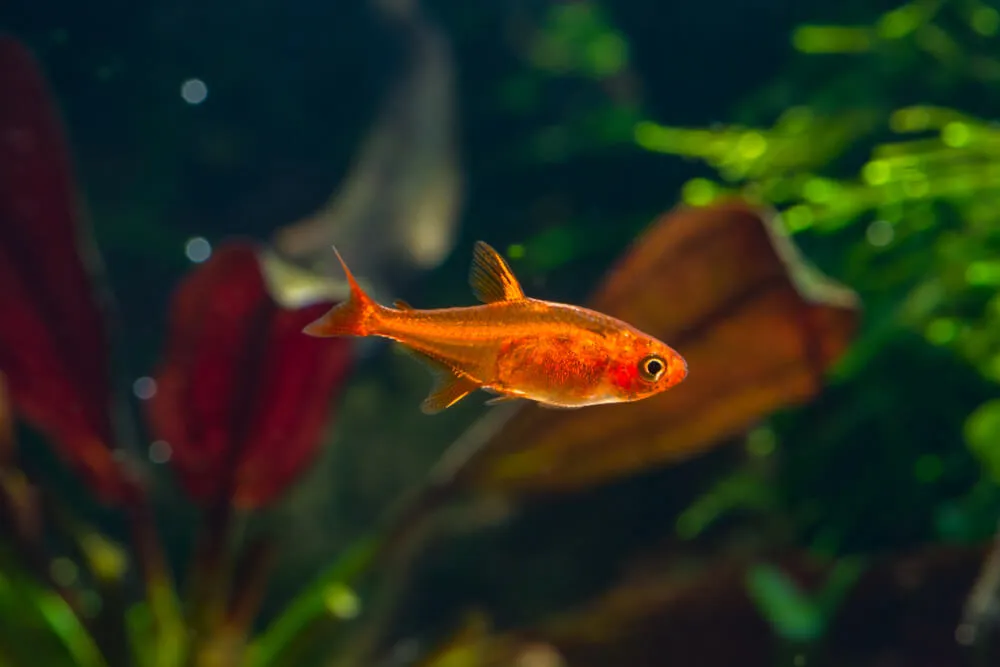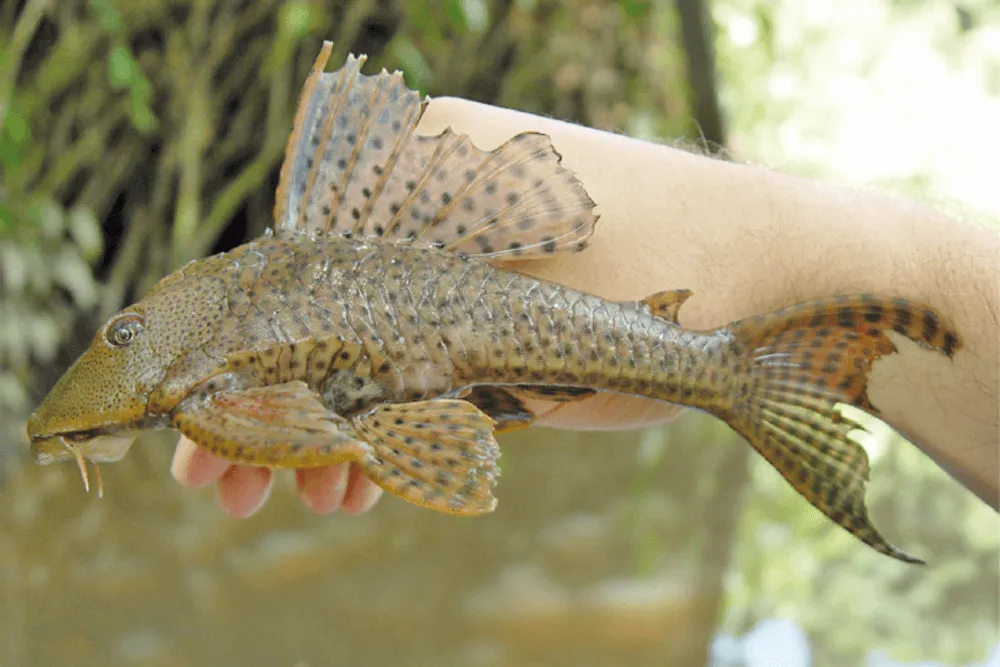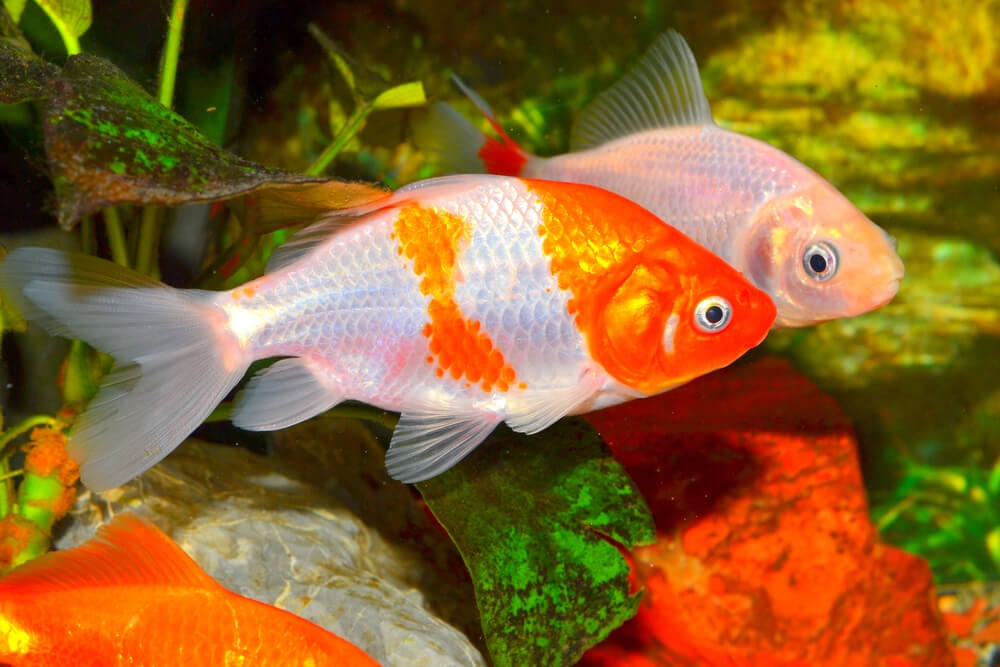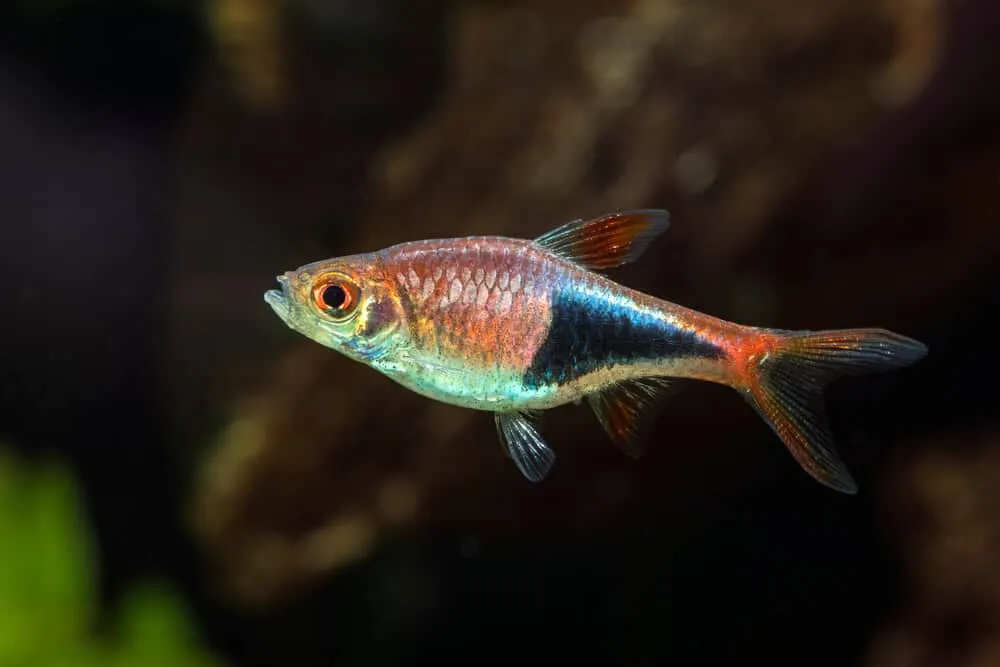Care Guide 101 Of Ember Tetras For Beginner And Experienced Aquarists

The Ember Tetra (Hyphessobrycon amandae) is popularly known for its cute size and vivid red-orange color. These characteristics make them stand out to both novice and experienced aquarists.
They are peaceful and social creatures. It is a must to keep them in groups with other small and non-aggressive fish species.
Their small body and vibrant color add life and beauty in every aquarium. Fun fact, they are also known as Fire Tetras due to their intense hue and Bullet Tetras due to their cute size.
Although they are easy to take care of, there are still some things that you need to strictly manage to help them thrive in your aquarium.
Factors such as water temperature, diet, and water vegetation must not be overlooked to not shorten their lifespan.
Although they are small, Ember Tetras are actually important in maintaining the water quality in your aquarium.
Their main prey is zooplankton, a tiny organism that oftentimes causes destabilization in your aquarium system.
They also serve as a nice decoration in your aquarium due to their intense color. What’s more is that they are not usually shy. So, you and your guests can always see these beautiful fish swimming in your tank.
If you are considering adding Ember Tetras in your tank, get to know them first. Check out this ultimate care guide to be the best Ember Tetra keeper.
Physical Characteristics of an Ember Tetra
Bullet Tetra and Fire Tetra are some of the names that Ember Tetras go by. They got these names due to their physical characteristics. Get to know more of this below.
Appearance
One look at this fish and you will understand why it is called an Ember Tetra. Its metallic orange-red color is reminiscent of a gleaming ember which can easily make any aquarium look lively and colorful.
However, you need to watch out if its color becomes too pale or translucent. This only means that your Ember Tetra is not getting the proper diet it needs.
A fun fact about Ember Tetra is that it is also called as Bullet Tetra. Similar to a bullet, this small fish has a slim body.
It has transparent dorsal fins with a tail fin that is shaped like a triangle. Its back has a dark outline while underneath its body is almost transparent due to having no color.
The small size of the Ember Tetra makes it the perfect fish to your small tank since they don’t use too much space.
Color variations
The most commonly known color of Ember Tetras is bright orange. However, the intensity of this color will depend on their sex and their maturity.
Male Ember Tetras are deep orange that is closer to red or scarlet. This becomes more vivid as they mature.
Their female counterparts, however, usually have a faded orange hue. Although faded, the metallic shine could still not be missed.
Don’t be bothered about the pale color complaints of other Ember Tetra owners. This could only mean they are not taking care of them very well.
However, remember that they may not be as vibrant in the aquarium as they are in the wild because they are not in their natural habitat.
Size and lifespan
The average Ember Tetra is only 0.5 – 0.8 inches long (1.5 cm). If you have seen a fish that looks like them but are only bigger, then that is a different species.
They can live between two and four years. This, of course, depends on how well you take care of them.
If you want them to live long enough, great consideration must be taken regarding its habitat, water temperature, and diet. Their maximum lifespan rests in your hands as their pet owner.
Habitat and Natural Distribution
The Ember Tetra fish looks very peaceful compared to their wild and diverse natural habitat. They may be small, but their terrible and attractive characteristics are what kept them alive.
It is important to know the natural habitat of Ember Tetras because you need to mimic this to your aquarium. This will make your aquarium an ideal living environment for them.
Native range of Ember Tetra
The Ember Tetras are natives to Central-Western Brazil. They are usually found in lukewarm freshwater basins that is surrounded with heavy vegetation there.
They come from the characin family. Most of the fish belonging in this family are usually small and colorful.
They are widely distributed all over the wilderness of the Araguaia River basin of Brazil. They flourish among the heavy vegetation of these river basins.
Due to their appearance and low maintenance costs, they became a popular pet fish and are being distributed in the global aquarium trade industry today.
Aquarium setup
For beginner aquarium hobbyists, starting with a 5-gallon small tank is enough since Ember Tetras are little in size. Start with five to eight individual tetras to play it safe.
For the experienced aquarists, adding them in a large tank is also fine as long as there are no bigger fish that may eat them.
Even as an experienced aquarium hobbyist, it is best to play it safe when it come to the living conditions of Ember Tetras.
Also, it is necessary to consider the size of the group of Ember Tetras that you are going to keep in your tank. A tank full of Ember Tetras is not advisable no matter how big or small it is.
Remember that they are a shoaling fish, which means they need company. Keeping only one can cause stress and will affect their health, even if you will provide it with the best living environment.
Six to eight Ember Tetras are enough for a 10-gallon aquarium while a shoal of 10-15 is enough for larger tanks.
Although Ember Tetras are social to other fish, there are times that they also need to hide and rest. For this, adding enough aquatic plants, whether plastic or live, in your tank can solve this problem.
It is best to mimic their natural habitat to help them thrive more. You can add Hornwort, Java Moss, and Anacharis to your tank.
What makes these aquatic plants also great is that they can improve the water quality in your tank.
While adding some vegetation in your tank can make it look dark, you don’t have to worry since Ember Tetras are blackwater fish. They may even get brighter in dark layers and background.
If you insist on adding fancy lights to your aquarium set-up, soft and dimmed LED lights are highly recommended to not stress out and disrupt your Ember Tetras.
Don’t forget to add some mineral rocks and a bit of sand to your aquarium, too. Your Ember Tetras will definitely enjoy them since it mimics their original home.
As for the water flow, it is best to keep it slow just like the relaxing rivers in Brazil. A high-quality gentle filtration via a sponge is highly recommended as well.
Water conditions and temperature requirements
The following conditions are proof that the Ember Tetra fish doesn’t need a high-maintenance care system. This is the main reason why they are perfect for beginners and experienced hobbyists alike.
That said, here are the conditions to keep in mind when caring for a Blue Tetra:
Always maintain the water temperature between 73°F and 84°F, keeping in mind that their natural habitat are the warm freshwater basins in Central Brazil.
Alkaline water can make Ember Tetras weak and idle. That is why the pH level should be within the range of 5.0 to 7.0, with 6.5 being the optimal acidic scale.
Water hardness is determined by the amount of calcium and magnesium dissolved in the water. Regulating this is necessary since it can stress or even kill the fish.
The recommended water hardness range for Ember Tetras is 5 to 17 dGH.
To keep your Ember Tetras in top shape, conduct regular level tests to your tank. You can do this on your own for at least once or twice a week. Test kits are available in the market.
Tank Mates
Ember Tetras are social creatures. Keeping only one will greatly deteriorate their health. Starting out with a group of six to eight Ember Tetras for a small tank is enough to keep them company.
Their social nature makes them the perfect tank mates for small and not aggressive fish. Not only that, they are peaceful towards any fish, too, so you don’t have to worry about them disrupting others.
However, it is important to consider the size of their other tank mates. Some big fish may think of your Ember Tetras as colorful snacks and will end up being eaten instead.
Ember Tetras are best to pair with bottom-dwelling and surface-dwelling fishes since they usually swim in the middle.
An example of a bottom-dwelling fish is the Corydoras catfish while a hatchet fish is also a safe option for a surface-dwelling fish.
Other perfect tankmates for Ember Tetras are Cardinal tetras, Otocinclus, Guppies, Harlequin Rasboras, and Glowlight tetras.
Feeding and Diet
Ember Tetras don’t have a special diet since they all are omnivores. They only need a perfectly-balanced meal to grow and develop well.
For more information, check out the details below.
Dietary needs and food types
Ember Tetras are omnivores, which means they will eat a variety of foods, including small live, frozen, and dry foods.
Fish flakes are the base of their diet. It is their primary source of protein.
You can also add brine shrimp, zooplankton, bloodworms, pellets, and Daphnia to provide more protein and other needed nutrients for them.
You don’t have to worry about giving them snacks since they can simply feed on the live plants in your aquarium.
However, keep in mind that it is impossible for them to eat all of the vegetation in your aquarium because they are too small to do that.
Just keep your aquarium vegetation in check because there might be times when you need to replace it with a new one.
Feeding habits and frequency
You can feed Ember Tetras for 2-4 times a day. If you are too busy, three feedings are considered enough for them.
Adjust the size of the food to the size of your Ember Tetras, too. Their small bodies can only eat much, so cut your food to bite-sized pieces first before feeding it to them.
Giving them large chunks will only give them a harder time to eat and digest it. It can also lead to a dangerous build-up of leftover food.
Lastly, leftover food can mess up the living conditions in your tank. When it is your first time to feed them, start with a small amount first, then continue on adding more when needed.
Importance of a balanced diet
As with every other fish, a balanced diet is key to a longer lifespan for Ember Tetras. In fact, healthy and varied food can also make their color look more solid and brighter.
Always prepare a variety of food to help your Ember Tetras receive all the essential nutrients and vitamins for their growth and development. Also, avoid from overfeeding them.
When it comes to food, they are just like us, humans, too. So, avoid feeding them too much processed food to avoid digestive issues.
Overfeeding your fish can lead to poor water quality, which can be harmful to your Ember Tetras.
Breeding Ember Tetra
Just as how easy it is to raise Ember Tetras; they are also incredibly easy to breed. They only require few and simple changes in their environment.
Sexual differences
It is easy to spot a male and female Ember Tetra even to an untrained eye. The trick is to study their colors and shape.
Male Ember Tetras tend to have the brightest almost scarlet color. This color becomes more prominent as they mature.
The mature female Ember Tetras, however, only have a metallic yet faded orange color.
Their shape also indicates their sex. Mature female Ember Tetras tend to be rounder compared to the slender males.
Female Ember Tetras are also easy to spot since they have bigger air or gas bladders. During breeding season, their bladders seem to flatten as well.
Conditions required for successful breeding
First on the list is to make sure that your male and female Ember Tetras are at least six months old. You may start transferring them to a breeding tank two to three weeks before the mating season starts.
There may be instances where the male Ember Tetras will get too aggressive towards their female counterparts. When this happens, remove the females from the tank immediately.
A sign that the mating season has started is when they become more playful than usual. Behaviors such as nodding and chasing at each other are all tell-tale signs.
In a breeding tank, place enough number of male and female Ember Tetras. You don’t need to have a specific male to female ratio though.
The number of times they breed in a year depends on how large their group is. Sometimes, they won’t even need any external assistance to breed.
The water temperature in your tank for breeding should be within the range of 80-82°F. The recommended pH level should also be close to 7.
Hatching and raising of fry
A word of warning, Ember Tetras abandon their fry. This can be challenging, especially when there are other types of fish in the tank that may end up snacking on their eggs.
You should closely monitor your female Ember Tetras until the moment they give birth. Once they have delivered, you should immediately transfer the fry to another tank.
Note that if you are a first-time breeder, you have to closely monitor the pregnant tetras because they tend to lay their eggs everywhere.
When you are not careful enough, these eggs will surely get eaten by other aquarium creatures.
Ember Tetras only lay about six to twelve eggs. Their appearance is closely similar to transparent jellies.
Once you spot the eggs, place the male Ember Tetras in a different tank first, then get the eggs. We have to remove the males because they are the number one egg snackers.
The fry tank of Ember Tetra eggs should have the same conditions as the tank that they came from. Sticking close to the conditions of their natural habitat will ensure a successful hatch.
Ember Tetras grow fast in optimal environment conditions. You don’t have to wait for a long time for the eggs to hatch since it will usually take after 24-48 hours.
While they are still in their hatching tank, feed them with tiny and wet food. You may feed them with a boiled egg yolk.
To prepare this food, make a hardboiled egg first. Then, dissolve the egg yolk with water. You can now feed this to the fry.
You may transition from wet food to dry food as soon as they become grown-ups. You can also transfer them to a larger tank with other fish after a few weeks.
Conclusion
The Ember Tetra fish is a great introduction for beginner aquarists in the world of aquarium hobby. They are generally easy to breed and to care for.
It is best to mimic the natural habitat of Ember Tetras in your aquarium for them to thrive.
Conducting water tests to measure the pH level, hardiness, and temperature for at least once a week will help you maintain a suitable living environment for them.
Always remember that as a shoaling fish, Ember Tetras need to be in a group, may it be with their own kind or with other small and peaceful fish. Being in company keeps them from being stressed and sick.
Aside from their living environment, an important factor for a longer lifespan for Ember Tetras is a balanced diet.
They are omnivores, so make sure to prepare a variety of food rich in nutrients such as protein, and to feed them thrice a day.
In an ideal aquarium environment, Ember Tetras can live a minimum of two years. Their maximum lifespan can reach up to four years.
To maximize their vivid color, keep the background of your aquarium dark. Installing soft LED lights are an alternative if you want your tank to have a bit of light without outshining the color of your Ember Tetras.
As a pet, you can never go wrong with the freshwater Ember Tetra. Its fun and social personality coupled with their elegant color adds life to your aquarium.
Due to their social nature, you can often see them swimming in your tank. This makes them the perfect fish to show off to your friends or family during special occasions.
Taking care of Ember tetras can be a fun and rewarding hobby for beginner aquarium hobbyists. They don’t require a complicated care process, so you can still go about your other daily tasks.
You may be worried about shelling out a huge amount of money for them. The good news is you don’t have to since they only require a minimum amount of care.
This fish will set a general foundation on how to properly take care of other aquarium creatures. So, don’t be afraid to make small mistakes.
Ember Tetras don’t even have any specific diseases. The only time they will get sick is when you don’t provide them a balanced diet and when their water quality has gone low.
Although they only require minimum care, you still have to be mindful of them and their state. More than a decoration, they are living and breathing creatures, too.
For the experienced aquarists, Ember Tetras can be added as tank mates to your well-established fish collection. Just be sure that there are not kept with bigger fish that might confuse them as food.
Overall, the Ember Tetra is a low-maintenance freshwater fish that offers a fun environment to your tank when provided with the proper care and environment.
With a little time and effort, you can create a healthy and happy home for your tetras, and enjoy the beauty and peacefulness they bring to your aquarium.






